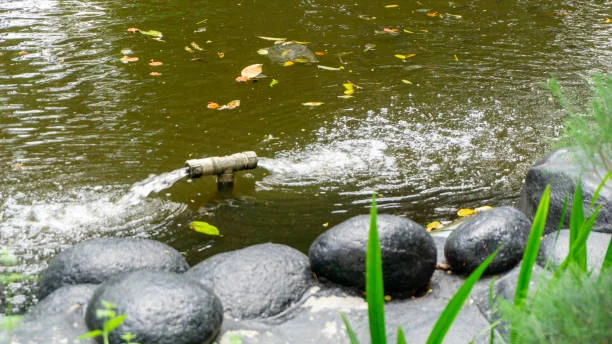That pond of yours was supposed to be a paradise. Instead, it’s a green, smelly swamp. It’s beyond frustrating Pond Suffocating.
If your water isn’t moving, your pond is dying. That stench and algae are just symptoms. The real problem is a simple lack of oxygen.
You don’t need a science degree. You just need to get the water moving. Aeration isn’t a luxury. It’s the most important thing you can do for a healthy pond – the difference between a vibrant ecosystem and a muddy headache.
One click away from more knowledge — explore this related gem today!
What Aeration Actually Does for Your Pond
People think aeration is just about adding oxygen. It’s so much more than that. Think of it as your pond’s circulatory system. It keeps everything alive and functioning Pond Suffocating.
When you aerate properly, you’re solving multiple problems at once:
It Breaks Down That Disgusting Sludge
That muck at the bottom? It’s poison. Aeration pumps in oxygen, fueling the good bacteria that devour this gunk. They naturally break down fish waste and leaves, cleaning your pond from the bottom up.
It Starves Algae
Algae love still, soupy water. Aeration mixes everything up, pulling the algae’s food down into the depths. No free lunch, no algae party. It’s that simple.
It Saves Your Fish
Fish need oxygen to survive. In a stagnant pond, oxygen levels can crash dramatically overnight – especially in hot weather or under ice. A proper aeration system ensures your fish can breathe easy year-round Pond Suffocating.
It Kills the Stink
That rotten egg smell? That’s what happens when your pond can’t breathe. Aeration pumps in fresh oxygen, stopping those nasty gases before they ever form. No more stink.
The Two Types of Aeration
For most ponds, you’re picking between two proven systems.
1. The Bottom-Up Workhorse (Diffused Aeration)
This is your go-to for serious, no-nonsense results – especially in deeper ponds. Here’s how it works: a durable pump sits on shore, pushing air through a weighted hose to a diffuser unit at your pond’s deepest point.
Those rising columns of bubbles do two critical things simultaneously. First, they create a current that drags oxygen-depleted water from the bottom up to the surface Pond Suffocating.
Second, they maintain an open area in the ice during winter, allowing toxic gases to escape. It’s the most efficient way to oxygenate the entire water column from the muddy bottom up.
2. The Pretty Powerhouse (Fountain Aeration)
If you want beauty and function combined, this is your pick. A floating unit draws water and propels it into attractive patterns in the air. The splashing action oxygenates the surface while creating a visual centerpiece for your landscape.
Fountains work best in shallower ponds where aesthetics matter. They’re perfect for decorative water features where you want that pleasing sight and sound of moving water. Just understand that their mixing power concentrates mostly in the top few feet.
How to Pick Your Aeration System
Shopping for aeration is confusing. Everyone says they’re the best. Here’s what actually matters for your pond.
Size And Depth Matter Most
For small, shallow ponds (under 6 feet deep), a quality fountain might be all you need. But for larger, deeper ponds? You absolutely need a bottom-up diffused system. The deeper your pond, the more critical bottom-up circulation becomes.
What’s Your Main Goal?
Are you trying to save fish from winter kill? A diffused system is non-negotiable. Just want to prettify a small decorative pond? A fountain could work perfectly. Trying to break down decades of accumulated muck? Go with the workhorse.
No Power Outlet? No Excuse.
Is your pond in the middle of nowhere? Good news. Solar and wind-powered aerators actually work now. The tech has gotten way better, so you can aerate anywhere.
Don’t Forget About Shape
A long, narrow pond might need two smaller units instead of one massive one. An irregular shape with coves might require strategic placement to eliminate dead zones where water goes stagnant.
The Truth About Installation
These systems are surprisingly simple to set up.
- For a bottom-up system: Put the pump somewhere dry, run the hose to the pond, and toss the bubbler in the deep end.
- For a fountain: Just anchor it and plug it in.
The maintenance is even simpler than the installation:
- Clean the pump’s air filter once a year – it takes five minutes
- If bubble output decreases after a few seasons, it’s usually just a cheap, easy seal replacement
- For fountains, just wipe off any debris from the intake
This isn’t a high-maintenance relationship. It’s a set-it-and-mostly-forget-it solution that works 24/7 to keep your pond healthy Pond Suffocating.
What Happens if You Do Nothing
Ignore aeration, and your pond’s problems will only get worse. The sludge gets deeper, the algae takes over, and your fish will eventually die. Every year you wait, the mess gets harder to fix.
The relatively small investment in a proper aeration system saves you money long-term on chemicals, fish replacement, and constant battling of symptoms. It transforms your pond from a high-maintenance problem into a low-maintenance asset.
Ready to Fix This for Good?
You’re tired of fighting algae and sludge. That’s just treating the symptoms. Fix the real problem instead: your pond needs to breathe. Get the water moving and stop wasting your weekends on a losing battle.
A properly aerated pond becomes what you always wanted: a beautiful, natural oasis that mostly takes care of itself. The difference is night and day – and your fish, your plants, and your weekend schedule will all be thankful. Tired of guessing? Get a straight answer from the pros. The Pond Doctors at Pond Perfections will help you choose the right pond aeration solutions for large and small ponds that actually work in our Canadian climate.
Keep discovering — explore more to stay ahead of the curve at 2A Magazine.







